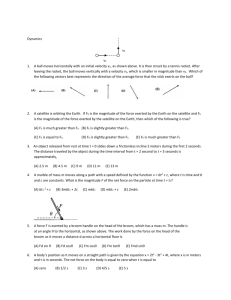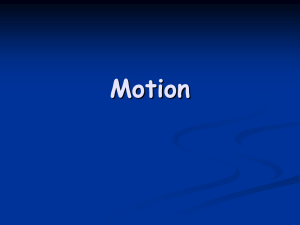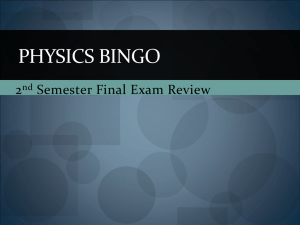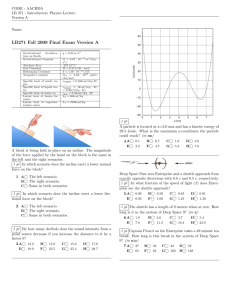Document
advertisement
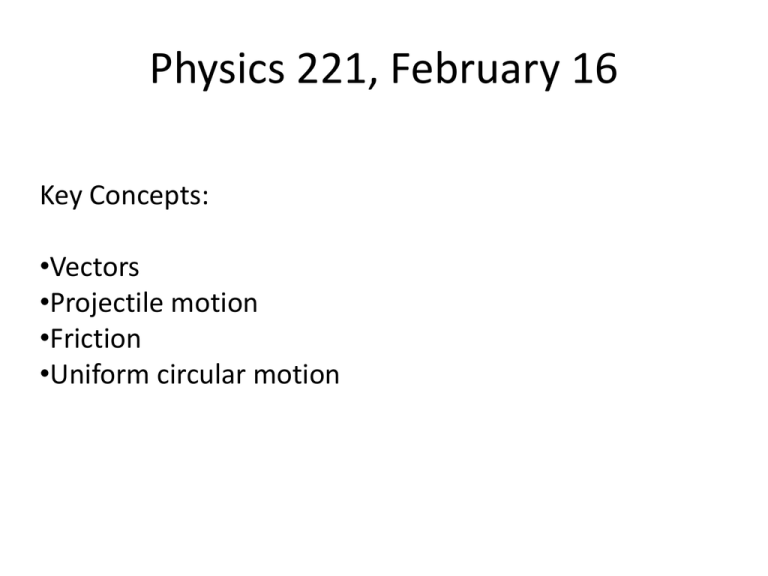
Physics 221, February 16 Key Concepts: •Vectors •Projectile motion •Friction •Uniform circular motion Vector addition Add two vectors, A an B. R=A+B Find the x- and y-components of each vector. Find the components of R. Find the magnitude and direction of R. What is the magnitude an direction of the vector C = A + B? 1. 2. 3. 4. 5. 4, 2, 8, 1.41, 2.83, 45 deg 270 deg 225 deg 45 deg 225 deg 30 0% 1 0% 2 0% 3 0% 4 0% 5 Extra credit: Vector A has magnitude 10 and vector B has magnitude 15. What is NOT a possible magnitude of vector C = A + B? 1. 2. 3. 4. 5. 4 8 12 16 20 0% 1 0% 2 0% 0% 3 4 0% 5 30 F = ma: no acceleration no net force If the component of the acceleration in a certain direction is zero, then the component of the net force in that direction is zero. On the incline the mass does not accelerate in a direction perpendicular to the incline. The component of the net force perpendicular to the incline is zero. Normal force: n = mg cosθ Along the incline: ma = mg sinθ A 30 kg penguin slides down the side of a glacier that has a constant slope of 50°. What is the magnitude of the acceleration of the penguin and what is the magnitude of the normal force it feels? Neglect any friction. 1. 2. 3. 4. a = 7.5 m/s2, n = 189 N a = 9.8 m/s2, n = 294 N a = 6.3 m/s2, n = 225 N a = 9.8 m/s2, n = 300 N 30 0% 1 0% 2 0% 3 0% 4 Two blocks, one sitting on a table and the other heavier one hanging over its edge, are connected by a light string as shown in the figure. Which force makes the block on the table move, the tension in the string or the weight of the hanging block? 1. the tension 2. the weight 0% 1 0% 2 30 What is the acceleration of the blocks? The blocks accelerate together, the acceleration a is the same for both blocks. (1) m1g – T = m1a (2) T = m2a Insert (2) into (1). m1g – m2a = m1a Solve for a. a = m1g/(m1+m2) Friction The frictional force always acts between two surfaces, and opposes the relative motion of the two surfaces. Static friction: Kinetic friction: fs ≤ μsN fk = μkN N = magnitude of the force pressing the surfaces together What is the direction of the frictional force on the block if i) ii) iii) the block is at rest on the ramp? the block moves up the ramp? the block is moves down the ramp? Assume the car is accelerating towards the right. A cup of coffee left on the roof is accelerating with the car at the same rate. What is the direction of the frictional force on the cup? 1. 2. 3. 4. 5. Towards the right Towards the left Up Down Down and towards the left 30 0% 1 0% 2 0% 3 0% 4 0% 5 When sliding a heavy box across the floor, it is often times helpful to lift up on it slightly because 1. 2. 3. 4. you are lessening the friction force by reducing the normal force the floor exerts on the box. you are reducing the weight of the box. you are working against friction by lifting up. you are working against gravity, even if the box does not move upwards. 0% 1 0% 0% 2 3 0% 4 30 Extra credit: You are walking with your friend along a beautiful shoreline and begin talking about physics. She says “I completely understand friction from physics class! It always acts against the motion of an object, slowing it down. Your friend’s statement is correct. 1. Yes 2. No 0% 0% 30 1 2 Projectile motion Projectile motion is motion of a particle through a region of space where it is subject to constant acceleration. Let the acceleration be along the y-direction and let the trajectory lie in the xy-plane. Then vx = v0x, x = v0xt, vy= v0y + at, y = v0yt + (1/2)at2. The motion along the x-direction is independent of the motion along the y-direction. If a = -g then vx = v0x, x = v0xt, vy= v0y - gt, y = v0yt - (1/2)gt2. A ball is thrown horizontally from the roof of a 25 m tall building with a speed of 20 m/s. What is its acceleration just before it hits the ground? 1. 2. 3. 4. 0 25 m/s2, horizontal 9.8 m/s2, downward greater than 9.8 m/s2 to the right and downward. 0% 1 0% 2 0% 3 0% 4 30 Three identical balls are thrown off a building, all with the same initial speed. Ball 1 is thrown horizontally, ball 2 is thrown at some angle above the horizontal, and ball 3 is thrown at some angle below the horizontal. Rank the speeds of the balls as they reach the ground. 1. 2. 3. 4. v1 = v 2 = v 3 v3 > v 1 > v 2 v1 > v 2 = v 3 v2 > v 1 > v 3 0% 1 0% 2 0% 3 0% 4 30 Demo • Ballistic cart http://www.youtube.com/watch?v=MhlTbNYh7VM Ball and cart have the same constant vx. The ball’s and the carts horizontal motions are the same. The ball’s vertical motion is independent of its horizontal motion and does not influence its horizontal motion. • Shoot the target http://www.youtube.com/watch?v=7y_ncpf81k8 Without gravity, the arrow would hit the original position of the target. With gravity, arrow and target accelerate downward at the same rate. Circular motion An object moving in a circle of radius r with speed v is accelerating. This acceleration is called radial acceleration or centripetal acceleration. This acceleration, ac, points towards the center of the circle. The magnitude of the centripetal acceleration vector is ac = v2/r. A force is required to make an object move in a circle. This force is called the centripetal force, with magnitude Fc = m v2/r. Fc points towards the center of the circle. Apparent weight When you stand on a bathroom scale in an inertial frame, such as this room, its reading Is proportional to your real weight. When you stand on a bathroom scale in an accelerating frame, such as an elevator accelerating upward, its reading is proportional to your apparent weight. In every accelerating frame we have wapparent = wreal - ma. For the elevator accelerating upward: wapparent = wreal – ma The apparent weight of a mass m is its real weight minus its mass times the acceleration of the frame (vector addition). In outer space, where wreal = 0, wapparent = – ma Some engineers have suggested that we can simulate gravity in outer space by having a circular rotating space station where persons feel an outward-directed fictitious force due to the rotation of the station. The reason they feel such a force is because 1. 2. 3. their velocity is toward the center of the space station and their inertia tends to keep them moving outward. they are accelerating toward the center of the space and the walls of the space station provide the centripetal force, which they experience as an apparent weight their velocity is away from the center of the space station and their inertia tends to make them move in towards the center. 0% 1 0% 2 0% 3 30 Extra credit: A ring shaped space station with a radius of 1 km is spinning, so that the speed of the rim is 50 m/s. A 60 kg man sits on the inside of the rim. What is his apparent weight? 1. 2. 3. 4. 5. 150000 N 3000 N 588 N 150 N 3N 0% 1 0% 2 0% 3 0% 4 0% 5 30


